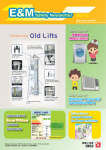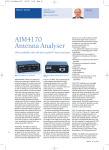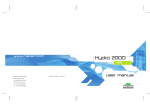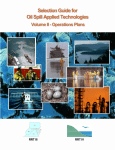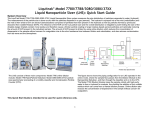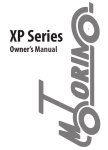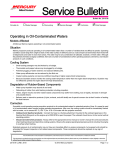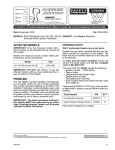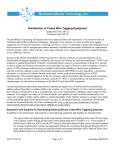Download Winter and Your Motorino
Transcript
Winter and Your Motorino Here are a few tips to help ensure a trouble-free winter season whether you are riding or storing your Motorino Electric scooter or bicycle. The following points are a general guide of what to look for so be sure to refer to the owner’s manual applicable to your scooter or bicycle for specific maintenance details, or take it to your Motorino dealer. Rider Safety The number-one priority and main challenge in winter riding is maintaining safety; the roads can be slick with fallen leaves, ice, and snow, and you spend more time riding in the dark. Being Seen: Make sure all lights and signals are operational and effective. At the very minimum, a bright headlight and taillight are absolutely necessary and beneficial even when riding in the daytime. Accessory helmet-mounted lights are never a bad idea. Reflective materials on your clothing and helmet are also highly recommended. Riding Gear: Being physically comfortable and at-ease is a huge component of safe riding. It’s hard to focus on the road surface conditions and traffic if you are also shivering with cold, having trouble gripping the handlebars, and can barely see through rain-covered or fogged lenses. As the Swedish like to say, “there’s no bad weather, only bad clothing.” Wear appropriately-warm water and wind-proof clothing (ideally in bright colours and with reflective materials) that won’t catch or restrict your range of riding motions. Rain-smearing and fogging of visors and goggles can often be minimized simply by keeping the surfaces perfectly clean. There are also a number of products designed to help: polishes and rain dispersants for the outside surface and anti-fog products for the inside surface of visors, glasses, or goggles (opinions of effectiveness and local sources vary – Google is your friend here). Mechanical Maintenance: The operator of any vehicle should always ensure that their machine is fully maintained and in good operating condition at all times but the winter elements make this absolutely critical. While your Motorino Electric bicycle or scooter has minimal maintenance needs when compared to a gas-powered vehicle, it is still a machine subject to the ravages of moisture, salty roads, and freezing cold. The guidelines in your owner’s manual should be adhered to but here are some points meriting special attention: Greenwit Technologies Inc.| Winter and Your Motorino 1 Tires As always, make sure your tires are in good condition, properly inflated, and appropriate for the conditions. Battery: Batteries have to work harder in cold weather and the chemical reactions that release their energy are slowed down. You can expect less range than in summer. However, as long as you keep the batteries fully charged, you need not worry about freezing or abnormal deterioration. If storing the bike, follow the storage charging schedule recommendations in your bike user manual. If regularly using your MOTORINO, just charge as often and as soon after riding as you can. Keep the charger dry yet well-ventilated at all times! Lubrication: Proper lubrication is the key to preventing rust, corrosion, and freezing of moving parts. Things are always going to get wet but as long as parts are oiled or greased as appropriate, it isn’t a problem. Warning! There are some areas that should never be oiled or greased! NEVER EVER apply oil, grease, or wax etc to the brake rotors, pads, drums, or shoes! The friction materials will be ruined, with possibly catastrophic results. Use brake cleaner on a paper towel to remove any accidental contamination. A bit of surface rust forming (as quickly as overnight) on the disc brake rotor is normal and is usually scraped away on first use of the brakes. DO NOT apply oil or grease to natural rubber parts (such as the rear shock mount bushings) with the exception of special lubricants (usually silicone-based) that are specifically intended for rubber; applying oil or grease to rubber parts will melt the rubber. If unsure, consult your dealer or use a rubber-safe lubricant. If you accidentally get oil or grease on a rubber part or your tires, wipe it away as best as you can and use dish detergent and hot water, or naptha (lighter fluid or camp fuel), to remove the residue. Here are the key lubrication points and recommended lubricants: Chain: light machine oil or chain-specific lube Bicycles with external derailleurs: a drop or three of light machine oil on all the hinge points and springs Kick, center, and side-stand pivots and springs: oil or light spray grease Brake lever pivots: machine oil or grease Greenwit Technologies Inc.| Winter and Your Motorino 2 Control cables (brakes, shifters): light machine oil applied to any exposed inner-cable, housing ends, and cable-end anchor points. Suspension forks/shocks: wipe clean any grime and then apply a very light smearing of oil on the polished sliding surfaces of the shock shafts and fork inner tubes. This will help prevent rust and keep them working smoothly. Bounce the bike up and down to work the oil into the seal area. Using too much oil or grease will attract and hold dirt that can contribute to wear, so keep it to just a smear. Suspension pivot points (applies to scooters with a rear swing arm): oil the pivot bolts where the trailing arm meets the frame. DO NOT put oil on the rubber bushings for the shock mountings. Cosmetics It’s not just about looks… Painted Parts: Carefully washing and waxing painted body panels and frame tubes will help protect the finish from the elements and is a good idea year-round. A layer of wax also prevents dirt from sticking. Chromed and expose metal parts: a very light application of lightweight machine oil will help keep rust at bay. Chrome parts can also be waxed the same as the body panels but the nooks and crannies will probably need oil anyway. Rinsing to remove road salt and grime is recommended whenever the bike is used or stored at temperatures above freezing (below freezing, the rust reaction slows down considerably). Parking and Storage The ideal place to park or store your bike is under cover in a dry and ventilated spot. This will give trapped moisture a chance to evaporate and help prevent corrosion and rust. A rain cover used outdoors for short periods is great but care must be taken to avoid creating a moisture trap over the longer term. Be especially wary of using a close-fitting cover over moist ground since it will concentrate water vapours. Greenwit Technologies Inc.| Winter and Your Motorino 3






